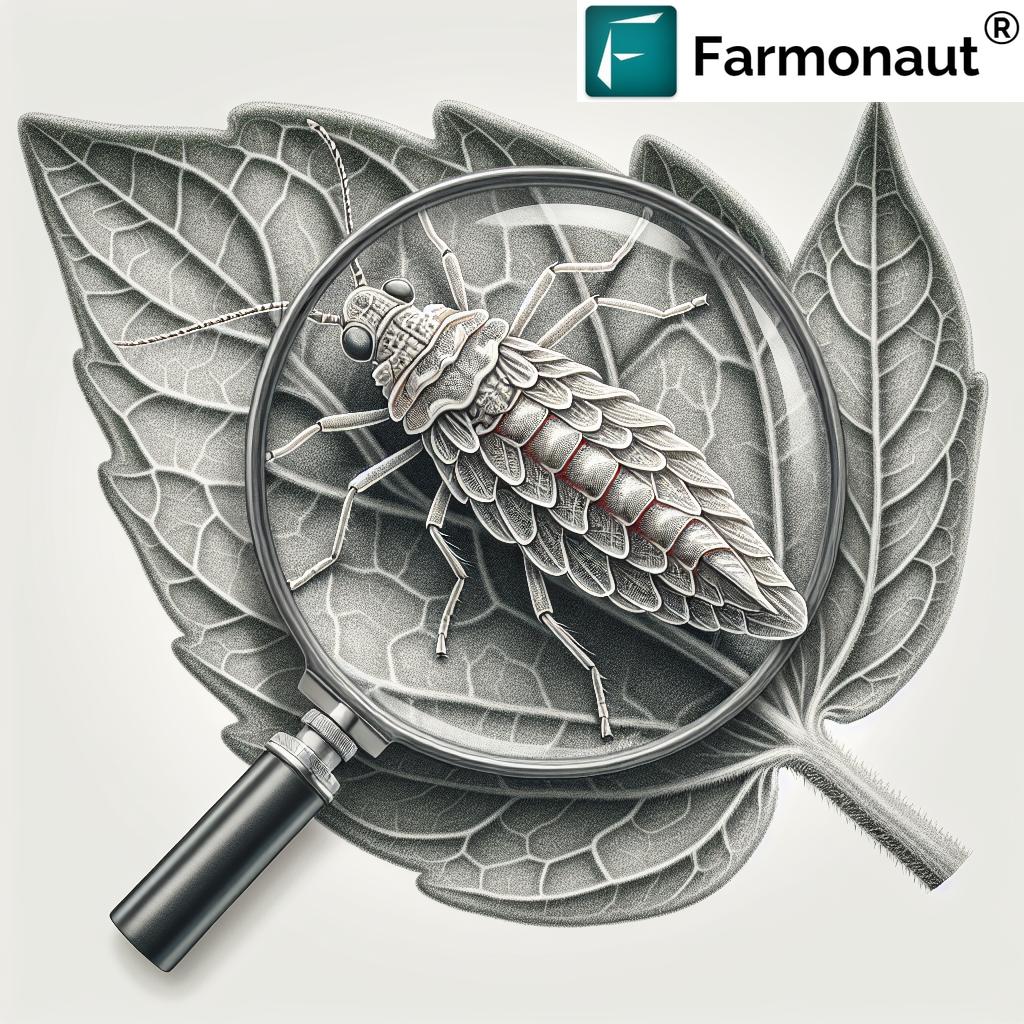Early Blight in Tomatoes and Potatoes: Organic vs. Chemical Treatment for Alternaria Solani Control

As agricultural technology experts at Farmonaut, we understand the critical importance of managing plant diseases effectively. Among the most prevalent and destructive diseases affecting tomato and potato crops is early blight, caused by the fungal pathogen Alternaria solani. This comprehensive guide will delve into the intricacies of early blight, its impact on crops, and the various treatment methods available, including both organic and chemical approaches.
Understanding Early Blight: A Threat to Solanaceae Crops
Early blight is a fungal disease that primarily affects plants in the Solanaceae family, with tomatoes and potatoes being particularly susceptible. The causal agent, Alternaria solani, is a notorious pest that can significantly impact crop yield and quality if left unchecked.
Symptoms and Identification
Recognizing the symptoms of early blight is crucial for timely intervention. The disease typically manifests as:
- Dark brown to black lesions on leaves, stems, and fruits
- Concentric rings within the lesions, giving a “target-board” appearance
- Yellowing and eventual death of affected feuilles (leaves)
- Premature defoliation, leading to reduced photosynthesis and plant vigor
- Sunken, leathery spots on fruits, particularly in tomatoes
Early detection is key to managing the disease effectively. At Farmonaut, we’ve developed advanced satellite-based monitoring systems that can detect early signs of crop stress, including early blight infections, across large agricultural areas.
The Impact of Early Blight on Crop Production
Early blight can have devastating effects on tomato and potato cultures (crops), leading to:
- Reduced photosynthetic capacity due to leaf damage
- Stunted plant croissance (growth)
- Decreased fruit size and quality
- Significant yield losses, sometimes up to 70% in severe cases
- Increased susceptibility to other pathogens
The economic impact of early blight can be substantial, making effective management strategies crucial for farmers and agricultural businesses.
Early Blight Detection: Traditional vs. Farmonaut Satellite System
| Method | Speed | Accuracy | Coverage | Cost-effectiveness |
|---|---|---|---|---|
| Visual Inspection | Slow | Moderate | Limited | Low |
| Lab Testing | Slow | High | Limited | Low |
| Farmonaut Satellite Monitoring | Fast | High | Extensive | High |
As demonstrated in the table above, Farmonaut’s satellite monitoring system offers significant advantages in early detection, large-scale monitoring, and cost-efficient management of early blight in tomatoes and potatoes.
Organic Treatment Options for Early Blight
For farmers and gardeners committed to organic production methods, several effective strategies can help control early blight:
1. Cultural Practices
- Crop rotation: Avoid planting Solanaceae crops in the same area for at least 2-3 years
- Proper spacing: Ensure adequate air circulation between plants
- Mulching: Use organic mulch to prevent soil splash onto lower leaves
- Pruning: Remove lower leaves and suckers to improve air circulation
- Watering techniques: Use drip irrigation or water at the base of plants to keep feuillage dry
2. Resistant Varieties
Choosing tomato and potato varieties with genetic resistance to early blight can significantly reduce disease incidence. At Farmonaut, we provide data-driven recommendations for suitable resistant varieties based on local climate and soil conditions.
3. Biological Control Agents
Several beneficial microorganisms can help suppress Alternaria solani:
- Bacillus subtilis
- Trichoderma spp.
- Pseudomonas fluorescens
These biological control agents can be applied as foliar sprays or soil treatments.
4. Organic Fungicides
OMRI-listed fungicides can be effective in controlling early blight:
- Copper-based products
- Sulfur-based fungicides
- Neem oil
- Potassium bicarbonate
It’s crucial to apply these products preventively or at the first sign of infection for optimal results.
Chemical Treatment Options for Early Blight
While organic methods are preferred for their environmental benefits, chemical treatments can be highly effective in controlling early blight, especially in severe cases or large-scale commercial operations.
1. Synthetic Fungicides
Several classes of fungicides are effective against Alternaria solani:
- Strobilurins (e.g., azoxystrobin, pyraclostrobin)
- Chlorothalonil
- Mancozeb
- Boscalid
- Difenoconazole
These fungicides should be applied according to manufacturer instructions and local regulations.
2. Integrated Pest Management (IPM)
At Farmonaut, we advocate for an integrated approach that combines chemical treatments with cultural practices and biological control methods. This strategy helps minimize fungicide resistance and reduces environmental impact.
3. Precision Application
Our satellite-based crop monitoring system enables precise fungicide application, targeting only affected areas and reducing overall chemical usage. This approach not only saves costs but also minimizes environmental impact.

Comparative Analysis: Organic vs. Chemical Treatment
When deciding between organic and chemical treatments for early blight, several factors should be considered:
Efficacy
- Organic treatments: Generally less immediate but more sustainable long-term
- Chemical treatments: Often provide quicker and more complete control, especially in severe infections
Environmental Impact
- Organic treatments: Minimal environmental impact, promotes soil health and biodiversity
- Chemical treatments: Potential for environmental contamination and negative effects on non-target organisms
Cost
- Organic treatments: Initially more labor-intensive, but potentially more cost-effective long-term
- Chemical treatments: Often less labor-intensive, but ongoing costs for fungicides can be significant
Resistance Management
- Organic treatments: Lower risk of pathogen developing resistance due to diverse control methods
- Chemical treatments: Higher risk of fungicide resistance if not managed properly
Farmonaut’s Role in Early Blight Management
At Farmonaut, we’re committed to helping farmers and agricultural businesses effectively manage early blight and other crop diseases through our advanced technology solutions:
1. Satellite-Based Crop Monitoring
Our satellite imagery analysis can detect early signs of crop stress, including early blight infections, across large areas. This enables timely interventions and targeted treatments.
2. AI-Powered Advisory System
Our Jeevn AI system provides personalized recommendations for early blight management based on real-time crop health data, weather forecasts, and historical patterns.
3. Precision Agriculture Tools
We offer tools for precise application of treatments, whether organic or chemical, helping to optimize resource use and minimize environmental impact.
4. Data-Driven Decision Making
Our platform provides comprehensive data analytics to help farmers and agronomists make informed decisions about early blight management strategies.
To access these advanced features and more, visit our application page or explore our API services for integration with your existing systems.
Best Practices for Early Blight Prevention and Control
Regardless of whether you choose organic or chemical treatments, the following best practices can help prevent and control early blight in tomato and potato crops:
- Sanitation: Remove and destroy infected plant material to reduce inoculum levels
- Crop rotation: Avoid planting Solanaceae crops in the same area for at least 2-3 years
- Resistant varieties: Choose tomato and potato varieties with genetic resistance to early blight
- Proper irrigation: Water at the base of plants and avoid overhead irrigation to keep foliage dry
- Nutrient management: Maintain balanced soil fertility to promote plant health and disease resistance
- Regular monitoring: Inspect crops frequently for early signs of infection
- Timely intervention: Apply treatments at the first sign of disease to prevent spread
- Integrated approach: Combine cultural, biological, and chemical methods for comprehensive control
The Role of Weather in Early Blight Development
Understanding the relationship between weather conditions and early blight development is crucial for effective disease management. Alternaria solani thrives in specific environmental conditions:
- Temperature: Optimal growth occurs between 24-29°C (75-84°F)
- Humidity: High relative humidity (>90%) promotes spore germination and infection
- Leaf wetness: Prolonged leaf wetness periods (>8 hours) increase infection risk
- Rainfall: Frequent rain events can splash spores onto healthy plant tissue
At Farmonaut, our weather monitoring and predictive modeling capabilities help farmers anticipate high-risk periods for early blight development. By integrating weather data with crop health information, we provide timely alerts and recommendations for preventive actions.
Economic Impact of Early Blight and the Value of Effective Management
The economic consequences of early blight can be severe, particularly for commercial tomato and potato growers. Losses can manifest in several ways:
- Reduced yield due to defoliation and fruit infection
- Lower fruit quality, resulting in decreased market value
- Increased production costs for disease management
- Potential loss of organic certification if chemical interventions become necessary
Effective early blight management, facilitated by technologies like those offered by Farmonaut, can significantly mitigate these economic impacts. Our satellite-based monitoring and AI-driven advisory systems help farmers:
- Detect infections early, reducing the need for extensive treatments
- Optimize resource allocation for disease management
- Maintain higher crop yields and quality
- Reduce overall production costs
By leveraging data-driven insights, farmers can make informed decisions that balance disease control with economic considerations, ultimately improving their bottom line.
Future Perspectives in Early Blight Management
As agricultural technology continues to evolve, we at Farmonaut are at the forefront of developing innovative solutions for early blight management:
1. Advanced Genetic Resistance
Ongoing research in plant breeding and genetic engineering aims to develop tomato and potato varieties with enhanced resistance to early blight. Our data analytics can help breeders identify promising genetic traits for resistance.
2. Nano-technology Based Treatments
Emerging research in nano-formulations of both organic and chemical fungicides shows promise for more effective and environmentally friendly disease control. We’re closely monitoring these developments to integrate them into our advisory systems.
3. AI-Driven Predictive Modeling
Our AI algorithms are continuously improving, enhancing our ability to predict early blight outbreaks with greater accuracy and longer lead times. This allows for more proactive and precise management strategies.
4. Drone-Based Monitoring and Treatment
While our current focus is on satellite imagery, we’re exploring the integration of drone technology for even more detailed crop monitoring and targeted treatment application.
5. Blockchain for Treatment Traceability
Our blockchain-based traceability solutions can be extended to track the application of early blight treatments, ensuring compliance with organic certification requirements and enhancing consumer trust.
Conclusion: A Holistic Approach to Early Blight Management
Early blight remains a significant challenge for tomato and potato growers worldwide. While both organic and chemical treatment options have their merits, a holistic, integrated approach often yields the best results. At Farmonaut, we believe that the future of early blight management lies in the intelligent integration of traditional agricultural knowledge with cutting-edge technology.
By leveraging our satellite-based monitoring, AI-driven analytics, and comprehensive farm management tools, growers can:
- Detect early blight infections at their earliest stages
- Implement targeted, efficient treatment strategies
- Minimize economic losses and environmental impact
- Make data-driven decisions for long-term crop health and productivity
We invite farmers, agronomists, and agricultural businesses to explore how Farmonaut’s technology can revolutionize their approach to early blight management and overall farm productivity. Visit our website or download our mobile app to get started:
For developers interested in integrating our powerful API into their own agricultural solutions, please refer to our API documentation.
FAQs about Early Blight Management
- Q: Can early blight be completely eradicated from a field?
A: Complete eradication is challenging due to the pathogen’s ability to survive in soil and plant debris. However, with proper management practices, including those facilitated by Farmonaut’s technology, the disease can be effectively controlled and its impact minimized. - Q: How often should I monitor my crops for early blight?
A: Regular monitoring is crucial, especially during periods of high risk. With Farmonaut’s satellite monitoring, you can receive daily updates on crop health, allowing for continuous vigilance without the need for constant manual inspections. - Q: Are organic treatments as effective as chemical fungicides against early blight?
A: Organic treatments can be highly effective when used preventively and as part of an integrated management strategy. While they may not provide the immediate knockdown effect of some chemical fungicides, they offer sustainable, long-term protection with minimal environmental impact. - Q: How can Farmonaut’s technology help in early blight management for small-scale farmers?
A: Our technology is scalable and accessible to farmers of all sizes. Small-scale farmers can benefit from our mobile app, which provides personalized crop health insights and management recommendations based on satellite data and AI analysis, helping them make informed decisions without the need for expensive equipment. - Q: Is it possible to use both organic and chemical treatments in the same season?
A: Yes, an integrated approach that combines organic and chemical treatments can be effective. However, it’s crucial to carefully plan and time applications to maximize efficacy and comply with relevant regulations, especially for certified organic production.
By staying informed and leveraging advanced technologies like those offered by Farmonaut, farmers can effectively manage early blight and other crop diseases, ensuring healthy, productive harvests year after year.













